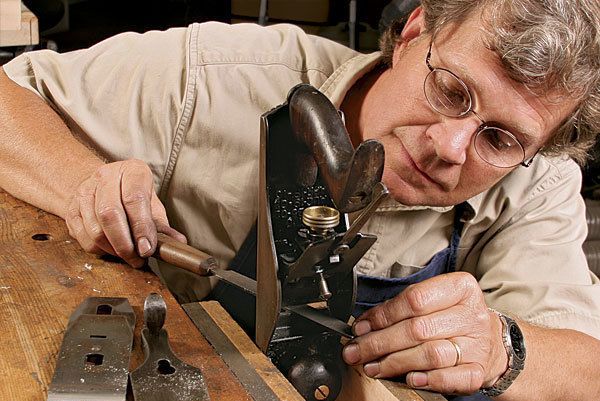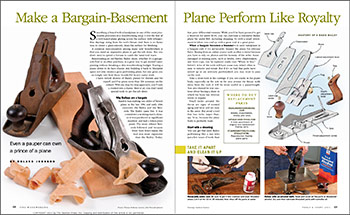How to Rebuild a Used Stanley Plane
How to transform a bargain-basement handplane into a top performer.

Synopsis: A common misconception among many new woodworkers is that you need an expensive plane to experience the joy of handplaning—the whisper-thin shavings, the tool gliding across the board, the glass-smooth, dead-flat result. Not true. You can get great results from a garage-sale find or an eBay purchase as long as you know what to do. Roland Johnson has rejuvenated dozens of Stanley Bailey planes and given more than 100 seminars on the subject. Here, he demonstrates how to tear down a plane to its bare chassis and rebuild it into a classic.
Smoothing a board with a handplane is one of the most pleasurable processes in a woodworking shop. I love the feel of a well-tuned plane gliding across the surface, with whisperthin shavings rising from the tool’s throat. And there is no faster way to create a glass-smooth, dead-flat surface for finishing.
A common misconception among many new woodworkers is that you need an expensive plane to get the job done. But you don’t need to spend a fortune to catch the hand-tool wave.
Rejuvenating an old stanley Bailey plane, whether it’s a garagesale find or an eBay purchase, is a great way to get started handplaning without breaking a slim woodworking budget. Tearing a plane down to its bare chassis and building it back to blueprint specs not only creates a great performing plane, but also gives you an insight into how these wonderful bench mates work. I have rebuilt dozens of Bailey planes for friends and for myself, and I’ve given more than 100 seminars on the subject. With my step-by-step approach, you’ll turn a clunker into a classic. Best of all, you don’t need special tools to get the job done.
Why Baileys are a bargain
Stanley was making two styles of bench plane in the late 19th and early 20th centuries: the Bailey and the Bedrock. The Bailey came first. It was considered a working-man’s plane, so it was produced in significant numbers and had a lower price point. The more refined Bedrock followed and because there were fewer made, the tool was more expensive than the Bailey. Today, that price differential remains. While you’d be hard-pressed to get a Bedrock for under $100, you can purchase a restorable Bailey plane for under $40, including shipping. so with a small investment in labor, you end up with a great tool at a great price.
When a bargain becomes a bummer—A used handplane is a bargain only if it’s serviceable. Inspect the plane for obvious flaws. Buying from an online source such as eBay is tricky because you have to rely on photos and the honesty of the seller. some damaged or missing parts, such as knobs, totes, chipbreakers, and lever caps, can be replaced easily. A lot of the tools will have some rust, which often is easy to remove and repair. But if it’s so bad that parts have seized up or are seriously pockmarked, you may want to pass on the tool.
Take a close look at the castings. If you see cracks in the plane body, especially on the sole in the area around the throat, walk away from the tool; it will be more useful as a paperweight. You also should be real cautious about buying a plane in which the body has obvious welds or repairs.
Small nicks around the throat are signs of normal aging and wear and are easy to file away. But avoid a tool that has nicks larger than, say, 1⁄8 in., because the plane body is probably toast.

From Fine Woodworking #216
To view the entire article, please click the View PDF button below:
Fine Woodworking Recommended Products

Suizan Japanese Pull Saw

Veritas Micro-Adjust Wheel Marking Gauge

Lie-Nielsen No. 102 Low Angle Block Plane








Log in or create an account to post a comment.
Sign up Log in